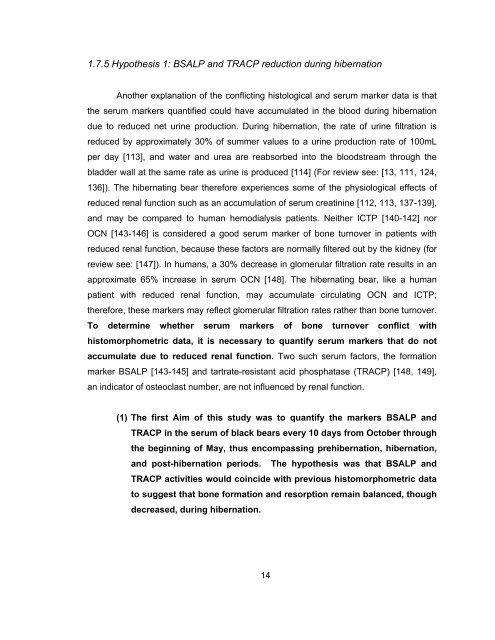C - Michigan Technological University
C - Michigan Technological University
C - Michigan Technological University
- No tags were found...
You also want an ePaper? Increase the reach of your titles
YUMPU automatically turns print PDFs into web optimized ePapers that Google loves.
1.7.5 Hypothesis 1: BSALP and TRACP reduction during hibernationAnother explanation of the conflicting histological and serum marker data is thatthe serum markers quantified could have accumulated in the blood during hibernationdue to reduced net urine production. During hibernation, the rate of urine filtration isreduced by approximately 30% of summer values to a urine production rate of 100mLper day [113], and water and urea are reabsorbed into the bloodstream through thebladder wall at the same rate as urine is produced [114] (For review see: [13, 111, 124,136]). The hibernating bear therefore experiences some of the physiological effects ofreduced renal function such as an accumulation of serum creatinine [112, 113, 137-139],and may be compared to human hemodialysis patients. Neither ICTP [140-142] norOCN [143-146] is considered a good serum marker of bone turnover in patients withreduced renal function, because these factors are normally filtered out by the kidney (forreview see: [147]). In humans, a 30% decrease in glomerular filtration rate results in anapproximate 65% increase in serum OCN [148]. The hibernating bear, like a humanpatient with reduced renal function, may accumulate circulating OCN and ICTP;therefore, these markers may reflect glomerular filtration rates rather than bone turnover.To determine whether serum markers of bone turnover conflict withhistomorphometric data, it is necessary to quantify serum markers that do notaccumulate due to reduced renal function. Two such serum factors, the formationmarker BSALP [143-145] and tartrate-resistant acid phosphatase (TRACP) [148, 149],an indicator of osteoclast number, are not influenced by renal function.(1) The first Aim of this study was to quantify the markers BSALP andTRACP in the serum of black bears every 10 days from October throughthe beginning of May, thus encompassing prehibernation, hibernation,and post-hibernation periods. The hypothesis was that BSALP andTRACP activities would coincide with previous histomorphometric datato suggest that bone formation and resorption remain balanced, thoughdecreased, during hibernation.14
















